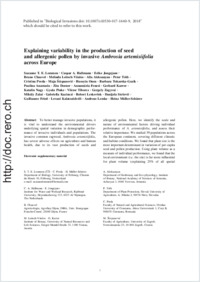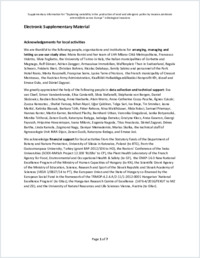Explaining variability in the production of seed and allergenic pollen by invasive Ambrosia artemisiifolia across Europe
- Lommen, Suzanne T. E. Department Of Biology, University of Fribourg, Switzerland
- Hallmann, Caspar A. Institute For Water And Wetland Research, Radboud University, Nijmegen, The Netherlands
- Jongejans, Eelke Institute For Water And Wetland Research, Radboud University, Nijmegen, The Netherlands
- Chauvel, Bruno Agroécologie, AgroSup Dijon, INRAUniv. Bourgogne Franche-Comté, Dijon, France
- Leitsch-Vitalos, Melinda Institute of Botany, University Of Natural Resources And Life Sciences, Vienna, Austria
- Aleksanyan, Alla Department of Geobotany And Eco-Physiology, Institute of Botany, National Academy of Sciences of Armenia, Yerevan, Armenia
- Tóth, Peter Department of Plant Protection, Slovak University of Agriculture, Nitra, Slovakia
- Preda, Cristina Agricultural Institute Of Slovenia, Ljubljana, Slovenia
- Šćepanović, Maja Faculty of AgricultureUniversity Of Zagreb, Croatia
- Onen, Huseyin Department of Plant Protection, Faculty Of Agriculture, Gaziosmanpasa University, Tokat, Turkey
- Tokarska-Guzik, Barbara Department of Botany And Nature Protection, Faculty Of Biology and Environmental Protection, University of Silesia in Katowice, Poland
- Anastasiu, Paulina Department of Botany And Microbiology & Botanic Garden “D. Brandza”, University of Bucharest, Bucharest, Romania
- Dorner, Zita Plant Protection Institute, Szent István University, Gödöllő, Hungary
- Fenesi, Annamária Hungarian Department of Biology And Ecology, Babeş-Bolyai University, Cluj-Napoca, Romania
- Karrer, Gerhard Institute of Botany, University Of Natural Resources And Life Sciences, Vienna, Austria
- Nagy, Katalin Faculty of Agricultural And Food SciencesSzéChenyi István University, Mosonmagyaróvár, Hungary
- Pinke, Gyula Faculty of Agricultural And Food SciencesSzéChenyi István University, Mosonmagyaróvár, Hungary
- Tiborcz, Viktor Institute of Botany And Nature Conservation, Faculty Of Forestry, University Of West Hungary, Sopron, Hungary
- Zagyvai, Gergely Institute of Botany And Nature Conservation, Faculty Of Forestry, University Of West Hungary, Sopron, Hungary
- Zalai, Mihály Plant Protection Institute, Szent István University, Gödöllő, Hungary
- Kazinczi, Gabriella Institute of Plant Science, Faculty Of Agricultural And Environmental Sciences, Kaposvár University, Kaposvár, Hungary
- Leskovšek, Robert Agricultural Institute Of Slovenia, Ljubljana, Slovenia
- Stešević, Danijela Biology Department, Faculty of Natural Sciences And Mathematics, University Of Montenegro, Podgorica, Montenegro
- Fried, Guillaume Laboratoire de la Santé des Végétaux, Unité Entomologie et Plantes Invasives, Anses Monferrier-sur-Lez, France
- Kalatozishvili, Levani Institute of Botany, Ilia State University, Tbilisi, Georgia
- Lemke, Andreas Department of Ecology, Plant Ecology And Ecosystem Science, Technische Universität Berlin, Germany
- Müller-Schärer, Heinz Department Of Biology, University of Fribourg, Switzerland
-
06.12.2017
Published in:
- Biological Invasions. - 2017, p. 1–17
English
To better manage invasive populations, it is vital to understand the environmental drivers underlying spatial variation in demographic performance of invasive individuals and populations. The invasive common ragweed, Ambrosia artemisiifolia, has severe adverse effects on agriculture and human health, due to its vast production of seeds and allergenic pollen. Here, we identify the scale and nature of environmental factors driving individual performance of A. artemisiifolia, and assess their relative importance. We studied 39 populations across the European continent, covering different climatic and habitat conditions. We found that plant size is the most important determinant in variation of per-capita seed and pollen production. Using plant volume as a measure of individual performance, we found that the local environment (i.e. the site) is far more influential for plant volume (explaining 25% of all spatial variation) than geographic position (regional level; 8%) or the neighbouring vegetation (at the plot level; 4%). An overall model including environmental factors at all scales performed better (27%), including the weather (bigger plants in warm and wet conditions), soil type (smaller plants on soils with more sand), and highlighting the negative effects of altitude, neighbouring vegetation and bare soil. Pollen and seed densities varied more than 200-fold between sites, with highest estimates in Croatia, Romania and Hungary. Pollen densities were highest on arable fields, while highest seed densities were found along infrastructure, both significantly higher than on ruderal sites. We discuss implications of these findings for the spatial scale of management interventions against A. artemisiifolia.
- Faculty
- Faculté des sciences et de médecine
- Department
- Département de Biologie
- Language
-
- English
- Classification
- Biological sciences
- License
- License undefined
- Identifiers
-
- RERO DOC 306817
- DOI 10.1007/s10530-017-1640-9
- Persistent URL
- https://folia.unifr.ch/unifr/documents/306412
Other files
Statistics
Document views: 89
File downloads:
- mue_evp.pdf: 197
- mue_evp_sm.pdf: 99

